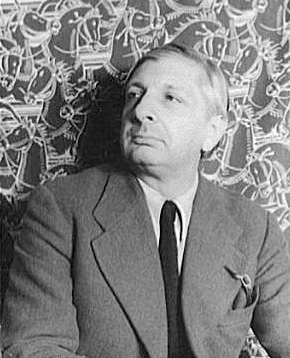
Giuseppe Maria Alberto Giorgio de Chirico was an Italian artist and writer born in Greece. In the years before World War I, he founded the scuola metafisica art movement, which profoundly influenced the surrealists. His best-known works often feature Roman arcades, long shadows, mannequins, trains, and illogical perspective. His imagery reflects his affinity for the philosophy of Arthur Schopenhauer and of Friedrich Nietzsche, and for the mythology of his birthplace.

Carlo Carrà was an Italian painter and a leading figure of the Futurist movement that flourished in Italy during the beginning of the 20th century. In addition to his many paintings, he wrote a number of books concerning art. He taught for many years in the city of Milan.

Metaphysical painting or metaphysical art was a style of painting developed by the Italian artists Giorgio de Chirico and Carlo Carrà. The movement began in 1910 with de Chirico, whose dreamlike works with sharp contrasts of light and shadow often had a vaguely threatening, mysterious quality, "painting that which cannot be seen". De Chirico, his younger brother Alberto Savinio, and Carrà formally established the school and its principles in 1917.
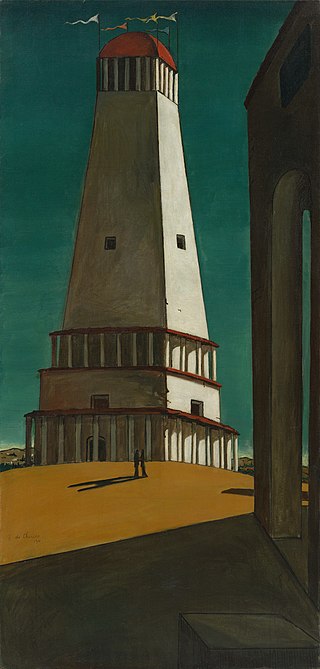
The Nostalgia of the Infinite is a painting by Italian metaphysical painter Giorgio de Chirico, dated of 1911, but most likely painted in 1912-113.

The Song of Love is a 1914 painting by Italian metaphysical painter Giorgio de Chirico. It is one of the most famous works by Chirico and an early example of his pre-surrealist style, though it was painted ten years before the movement was "founded" by André Breton in 1924.
Ariadne was a figure in Greek mythology.

Gare Montparnasse (The Melancholy of Departure) (Italian: La stazione di Montparnasse) is an oil on canvas painting by the Italian metaphysical painter Giorgio de Chirico, from 1914. It is held at the Museum of Modern Art, in New York.
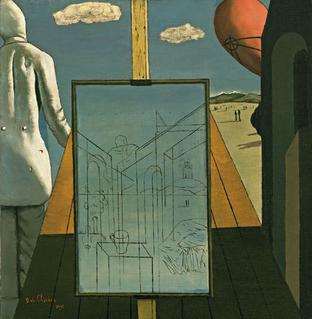
The Double Dream of Spring is a painting by the Italian metaphysical painter Giorgio de Chirico. It is held at the Museum of Modern Art, in New York.
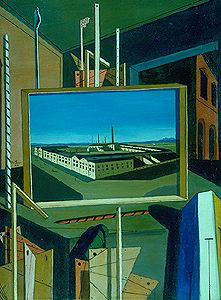
Metaphysical Interior with Large Factory is an oil-on-canvas painting by the Italian metaphysical painter Giorgio de Chirico, from 1916. It is part of a series that extended late into de Chirico's career.

The Disquieting Muses is a painting by the Italian metaphysical painter Giorgio de Chirico. There are two versions of this painting, the original is in the Gianni Mattioli private collection, in Milan, and the other is at the Pinakothek der Moderne, in Munich.
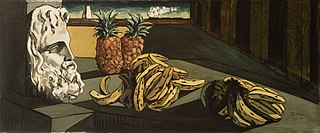
'The Transformed Dream is an oil on canvas painting by the Italian metaphysical painter Giorgio de Chirico, from 1913. It is held at the Saint Louis Art Museum, in St. Louis.

Giorgio Morandi was an Italian painter and printmaker widely known for his subtly muted still-life paintings of ceramic vessels, flowers, and landscapes—their quiet, meditative quality reflecting the artist's rejection of the tumult of modern life.
The Giorgio de Chirico Art Centre is an art centre/museum in a three-story building in Volos, Magnesia, Greece. It is named for internationally famous Italian artist Giorgio de Chirico, who was born to Italian parents in Volos on July 10, 1888.

The Giorgio de Chirico House Museum is a house museum in the 16th century Palazzetto del Borgognoni at Piazza di Spagna 31 in Rome. The house was acquired by Giorgio de Chirico in 1948. It was left to the state by his widow and opened as an art museum dedicated to his work in 1998. Only open by appointment, it is closed on Mondays and Sundays. The nearest Metro stop is Spagna.
Lili Ország 8 August 1926 – 1 October 1978) was a Hungarian painter.
The Prodigal Son is a painting by the Greek-born Italian artist Giorgio de Chirico. It is painted in tempera on canvas and was completed in 1922 as de Chirico was in transition from the Metaphysical style of his earlier works to the neoclassicism he essayed in the 1920s. The biblical subject matter is interpreted by de Chirico as a stone effigy of a father placing his hand on the shoulder of a mannequin representing the son. The dimensions of the painting are 87 by 59 centimeters. It is housed at Museo del Novecento, Milan, Italy.
Michael R. Taylor is a curator, author, and expert in modern and contemporary art with a focus on Dada, Surrealism, and the work of Marcel Duchamp. With a Ph.D in Art History from the Courtauld Institute of Art in London, he was a Curator of Modern Art at the Philadelphia Museum of Art from 1997 until 2011, and Director of the Hood Museum of Art at Dartmouth College in Hanover, New Hampshire from 2011 until 2015 In May 2015, the Virginia Museum of Fine Arts announced its appointment of Dr. Taylor as Chief Curator and Deputy Director for Art and Education.

The Soothsayer's Recompense is a 1913 painting by Italian painter Giorgio de Chirico. It is now in the Philadelphia Museum of Art as part of the permanent collection. It was accessioned in 1950 as one of the thousand items donated to the institution by Walter and Louise Arensberg. The piece was created in France, through a process of "squaring-up" in which Chirico drew a version of the piece divided into nine squares, and subsequently used this draft to quickly create the fleshed-out painting.

The Great Sirens is a large 1947 painting by the Belgian painter Paul Delvaux in the collection of the Metropolitan Museum of Art, in New York.

The Great Tower is an oil on canvas painting by the Italian artist Giorgio de Chirico, from 1921. It is held in the Pushkin Museum, in Moscow. The Russian Ministry of Culture acquired it in 1992 for the National Centre for Contemporary Arts, though the latter then transferred it to the Pushkin Museum in honour of its eightieth anniversary.














